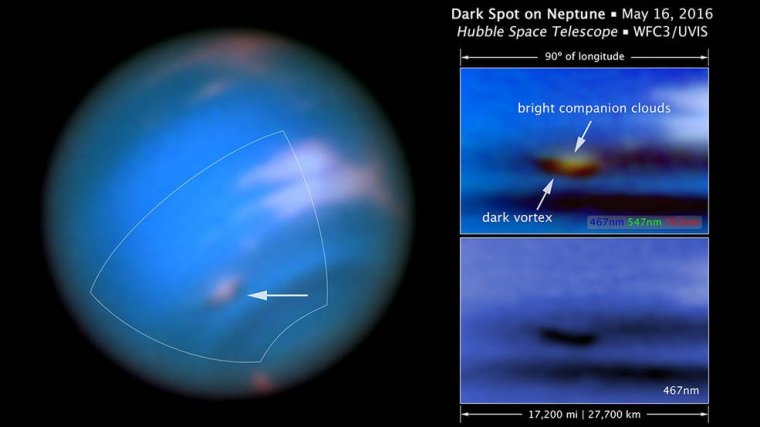| News / Space News |
Hubble Imagery Confirms New Dark Spot on Neptune
NASA | JULY 3, 2016
New images obtained on May 16, 2016, by NASA's Hubble Space Telescope confirm the presence of a dark vortex in the atmosphere of Neptune. Similar features were seen during the Voyager 2 flyby of Neptune in 1989 and by the Hubble Space Telescope in 1994.

A dark vortex in the atmosphere of Neptune. ![]()
Neptune's dark vortices are high-pressure systems and are usually accompanied by bright "companion clouds," which are also now visible on the distant planet. The bright clouds form when the flow of ambient air is perturbed and diverted upward over the dark vortex, causing gases to likely freeze into methane ice crystals.
Beginning in July 2015, bright clouds were again seen on Neptune. In September 2015, the Outer Planet Atmospheres Legacy (OPAL) program, a long-term Hubble Space Telescope project that annually captures global maps of the outer planets, revealed a dark spot close to the location of the bright clouds, which had been tracked from the ground.
By viewing the vortex a second time, the new Hubble images confirm that OPAL really detected a long-lived feature. The new data enabled the team to create a higher-quality map of the vortex and its surroundings.
Neptune's dark vortices have exhibited surprising diversity over the years, in terms of size, shape, and stability (they meander in latitude, and sometimes speed up or slow down). They also come and go on much shorter timescales compared to similar anticyclones seen on Jupiter; large storms on Jupiter evolve over decades.
Planetary astronomers hope to better understand how dark vortices originate, what controls their drifts and oscillations, how they interact with the environment, and how they eventually dissipate.
YOU MAY ALSO LIKE



